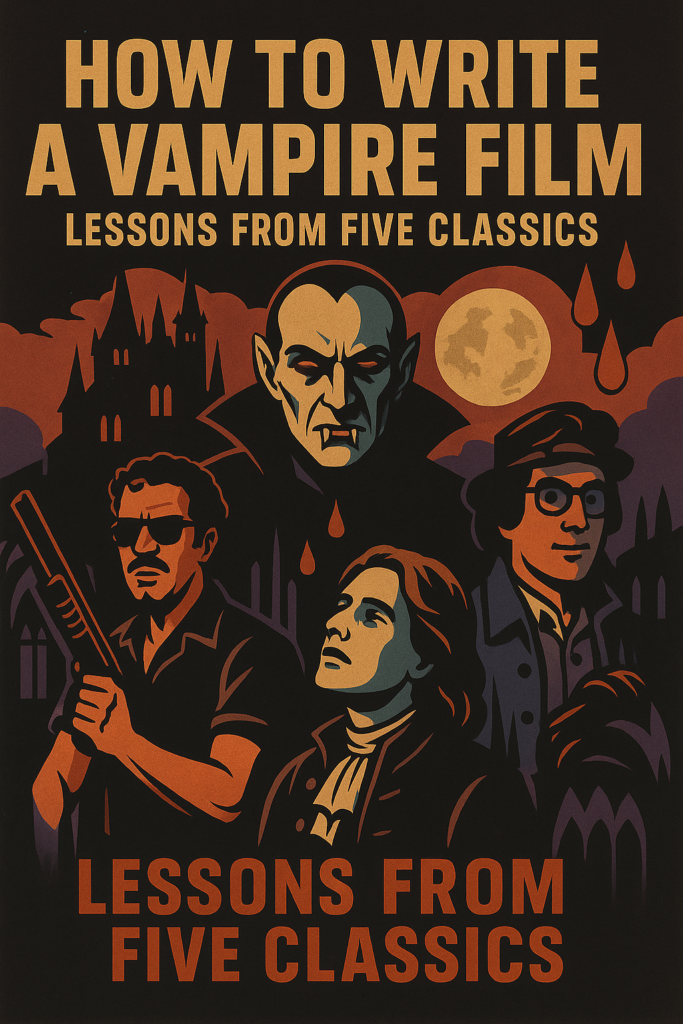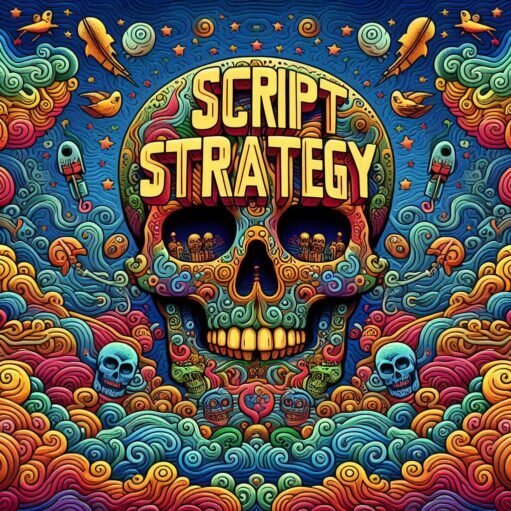How to Write a Vampire Film: Lessons for Screenwriters

Rules, Story Worlds, and Fetishism
Vampires navigate the boundary between life and death, pleasure and horror, intimacy and violence.
Notably, the best vampire films establish clear rules, build rich, moody environments, and explore the inherently sensual, parasitic nature of the vampire figure. These elements ground the supernatural in a world that feels viscerally real—and often frighteningly erotic.
Below are five vampire films that offer screenwriters serious lessons in how to construct a rich, genre-specific vampire story.
Bram Stoker’s Dracula (1992, dir. Francis Ford Coppola)
Lesson: Build rules and mystery around the vampire—and let others tell the story
Coppola’s lush, operatic Dracula hews close to Stoker’s original novel, particularly given that Stoker’s greatest narrative trick is keeping Dracula mostly offstage.
Dracula comes to life through fear and obsession of others—Jonathan Harker, Mina, Van Helsing. The vampire exists primarily as mystique. Dracula ultimately emerges as a psychosexual riot of tenderness, savagery, and gothic romance.
Coppola also sharpens the subtext for modern relevance. Frank Rich suggests that Coppola’s take on blood, infection, and sex arguably mirrors the AIDS crisis–much more current at the time–turning the vampire’s blood exchange into a metaphor for real-world horror.
Key takeaway: Build a suggestion of the monster with mystery and menace—but let the actual story be from through the eyes of those on the outside.
Writing Exercise:
Write three different people’s accounts of encounters with the same vampire.
Only show the vampire through the characters’ different emotions: fear, awe, lust, etc.
Remember, Stoker’s novel is effectively a collection of newspaper clippings and oral histories. Let contrast and contradiction create the monster.
From Dusk ’til Dawn (1996, dir. Robert Rodriguez / written by Quentin Tarantino)
Lesson: Vampire rules can infect any genre
It’s not really a vampire film. Until it is.
The first half is a violent thriller gone full Tarantino: criminals on the run, hostages, and a fateful pit stop at the only strip club in this godforsaken desert…
Note how vampire lore is grafted onto an entirely different genre, and it still works.
The characters figure out what to do through trial and error–and just barely enough to survive. Of course it’s the normal stuff we know, but these characters are simply improvising: they aren’t coming to with any sort of awareness of the vampire genre.
The beauty, in fact, is how they improvising.
By opening the floodgates mid-film, Rodriguez turns off the rare injections of sexuality–Richie’s perving at Kate and the iconic snake dance–and goes balls to the wall.
The effectively constructed, almost operatic action violence and fantastic makeup (courtesy of co-star Tom Savini) carry the day in this intentionally dumb genre classic.
Key takeaway: Put a vampire (or a hundred) in any genre, but make the rules clear and immediate.
Writing Exercise:
Take a genre that’s not horror–a romantic comedy, a buddy road trip, etc.–and write a scene where a vampire element is revealed halfway through.
Define one rule from classic vampire lore (e.g., no reflections, fear of holy water, can’t cross a threshold without invitation) that must be obeyed. Now force the characters to learn it the hard way.
Interview with the Vampire (1994, dir. Neil Jordan / based on the novel by Anne Rice)
Lesson: Vampires are cursed with eternity—make them fucking hate it
Louis (Brad Pitt) narrates his endless life, his bloodlust, and his guilt over killing—humanizing the monster by demonstrating to the Interviewer how he never wanted to be a vampire at all.
The genius of this film is its portrayal of the vampire life as a slow-burning existential crisis.
The vampires are deeply psychological, moody, and theatrical. Their pain becomes the drama.
Placing the story in New Orleans gives it a new Gothic atmosphere—moist, colonial, haunted by French and Catholic influence. It’s not London or Transylvania, but it feels equally ancient and rotting.
Key takeaway: Eternity can feel claustrophobic. The vampire must, by virtue of eternal life, contend with more trauma and loneliness than others.
Writing Exercise:
Write a journal entry from a vampire hundreds of years old. Focus on boredom, sorrow, obsession, or even disgust. Consider how the world has changed. What does the vampire miss. What does the vampire risk forgetting?
3a) An Honorable Mention: Only Lovers Left Alive (2013, Jim Jarmusch)
Its slow pace can seem taxing, but Jarmusch makes the film a beautiful meditation on how vampires have to deal with boredom as well as cultural relevance in their neverending world.
Outside its strong leads in Tilda Swinton and Tom Hiddleston, the film boasts memorable turns from Mia Wasikowska, Anton Yelchin, and the great John Hurt.
What We Do in the Shadows (2014, dir. Taika Waititi & Jemaine Clement)
Lesson: Explore vampire rules through absurd realism
This mockumentary takes vampire tropes and turns them into comic logistics. Floating through windows becomes awkward. Feeding on virgins is a struggle. It’s a ballache to have to be invited into the bar.
By accepting the absurdity of the rules and then playing them totally straight, the film’s comedy lies in showing how how impractical the life of the vampire is.
Particularly in modern-day Wellington. Remember how we talked about moody environments? This isn’t one.
Not least, it demonstrates how comedy works most clearly when the characters take themselves totally seriously.
Wellington, New Zealand, is the perfect backdrop: a sleepy, unassuming city that’s basically as far from where you’d expect to find a vampire as possible. On top of that, it’s full of hipsters, dull parties, and suburban banality—it might be the least likely vampire haunt imaginable.
Key takeaway: Explore every rule to its absurd conclusion. Make the magic totally mundane. But don’t forget that for a vampire, the mundane will can also be totally magical.
Writing Exercise:
Pick a vampire rule (see above) and write a vampire film scene in which a vampire’s attempt to live a “normal” life goes hilariously wrong because of that rule.
Bonus: set it in a city not associated with horror.
The Lost Boys (1987, dir. Joel Schumacher)
Lesson: Vampires live among us—and pop culture can hide their trail
Set in sun-bleached Santa Cruz, The Lost Boys gives us vampires as a motorcycle gang of hot, nihilistic teens.
The film reflects its era in full: at the time, the city was as “the mass murder capital of the world” and was once a functioning base for multiple serial killers.
Toss in missing kids on milk cartons (was it the serial killers or the vampires?), MTV aesthetics, comic book shops, and working parents’ concerns over their own latchkey kids.
In these ways, note how the vampire blends in with the 1980s reality that was already getting tired of itself.
The vampire becomes something attractive, confident, and mysterious—the perfect metaphor for teen rebellion. Note how most vampires want people out of their gang; this group is seeking members.
Key takeaway: Embed your vampires in the world of the moment. Use real pop culture, architecture, and generational fears to root the fantasy in now.
Writing Exercise:
Your protagonist’s sibling is being seduced by a vampire. Use only cultural references from today (social media, fashion, slang) to set a world and heighten the conflict.
Bonus: Twilight (2008, dir. Catherine Hardwicke)
Lesson: Lean into fantasy, even when it’s silly—and commit to the tone
Twilight is not a great film. The writing is flat, the pacing languid, the effects shaky. Even the book was pretty dull and melodramatic, but it’s better than this.
Somehow, though, this film knew precisely whom it was selling to and it basically became an occult 50 Shades of Grey.
The film nails the melodramatic sexual tension of vampire mythology—the vampire who wants you, but can’t touch you. This “abstinence erotica” – little surprise that the book’s author is a member of a notable religious sect (the sort that has broadway musicals written about them) – wraps the vampire lore around emotional intimacy, hilarious slow glances, and sometimes even danger.
Twilight understands one thing perfectly: the fantasy of being chosen, of being seen as unique and precious by a powerful creature, is apparently something teen girls want.
Key takeaway: Even a poorly made film can hit hard if it understands the emotional tone it’s selling.
Writing Exercise:
Write a vampire film scene where the monster seduces a human being (or hey, vice-versa) – yet the two cannot touch.
The tension must build through dialogue or breath. Maybe some nice slow gazes. Then at the end one just gets the overwhelming urge to turn heel and walk.
What Makes a Vampire Film Work?
The vampire is one of the most flexible figures in horror, precisely because it’s not just a monster—it’s a memeplex. Let’s look at what you need to propertly write a vampire film.
The vampire acts as a metaphor for desire, repression, hunger, loneliness, identity, addiction, and any number of other things you could map on top of it.
To write a great vampire film, you need:
- Rules – What can your vampire do? What can’t they do?
- Environment – Where do they live? What makes it strange and atmospheric?
- Sexuality – What’s erotic or grotesque about the feeding process?
- Perspective – Who tells the story? The vampire, or the prey?
- Tone – Gothic? Comedic? Exploitation? Existential?
Define these elements clearly, and you can use the fabulous body of vampire lore out there as a transfusion for the rest (sorry).

